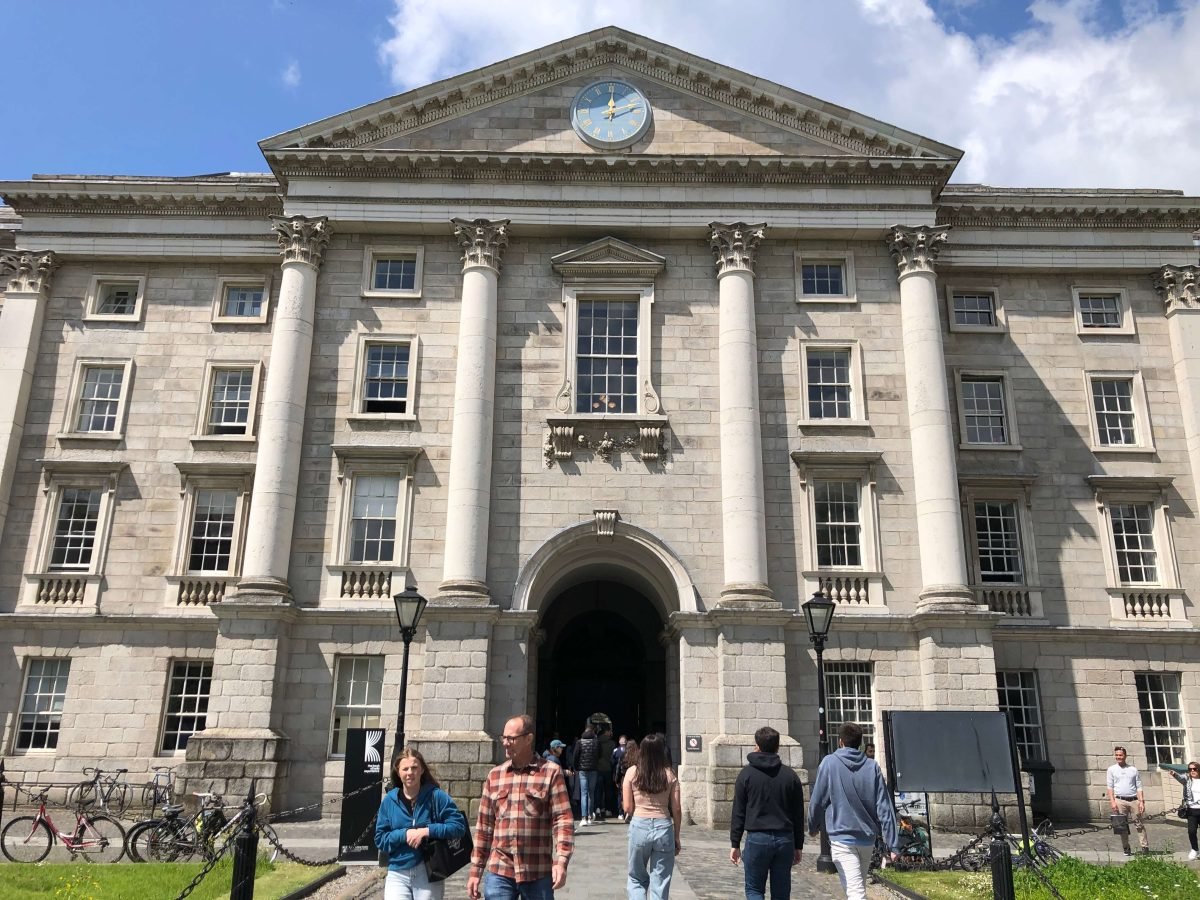Cover image: Trinity College Dublin. Photo (c) A Scholarly Skater, 2024.
Earlier this month, I finally did something I’ve dreamed about for years – I went to Dublin, Ireland and saw the Book of Kells in person! As my readers probably know, this is my favorite illuminated manuscript and one of my favorite artworks of all time. In this post, I’ll tell you about my dream-come-true experience.
If you are not yet familiar with this masterpiece and its significance, please click here to read more about it. But in short, the Book of Kells is an illuminated medieval gospel book made by Irish monks around the year 800 CE. It is celebrated for its intricate decoration, which is replete with color and symbolism, and has become one of the major symbols of Ireland. Trinity College Dublin, the country’s oldest and most famous university, owns the book and houses it in the school’s majestic Old Library.
Trinity College is in the middle of a long-term conservation project on the Old Library and the books within. In my understanding, the building will soon close for several years so the next phase of restoration can begin. The Book of Kells will be displayed somewhere else during the multi-year closure. Thus, I can only tell you about my experience in June 2024, which is not necessarily how yours will be in the future.
Trinity Trails

The first part of my visit was Trinity Trails, an historical walking tour of the campus led by a very enthusiastic Trinity student. (In case you are wondering, this is nothing like the kind of tour you get when you are a prospective university student.) You can book this tour in a package with your Book of Kells admission, and I highly recommend doing so, because it was very enjoyable.



In addition to learning about the school’s history and some of the famous people who have studied there, we stopped by a few significant buildings on campus. The only one we actually got to enter, though, is the so-called Museum Building that houses Trinity’s geology department. Built in the 19th century, it’s particularly interesting because it combines a Byzantine and Mediterranean-Romanesque inspired architectural design with hand-carved representations of native Irish plants throughout the interior and exterior. The building also uses all different kinds of stone and marble from Ireland and nearby lands; the distinctive green Connemara marble columns inside are particularly noteworthy.
The Old Library
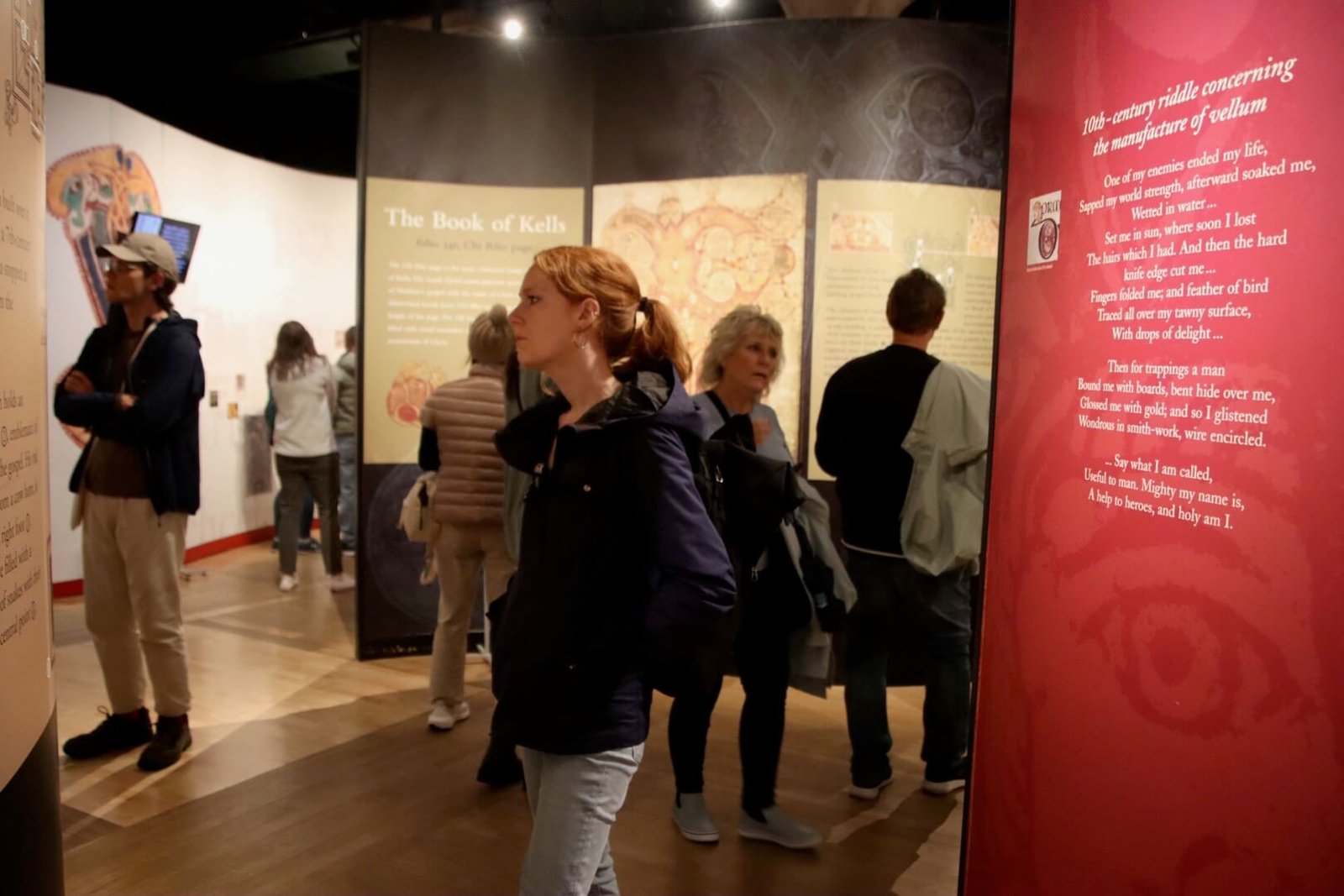
After Trinity Trails, we entered the Old Library. First, there was a really wonderful exhibition that introduced the early medieval Irish manuscript tradition. It discussed related manuscripts, scribes, the materials and techniques of manuscript making, and the significance and symbolism of the book’s imagery. Although there were few actual objects on display, the exhibition was filled with informative text panels, videos, and images, including huge enlargements of the book’s most iconic pages. I believe there’s also an audio guide component.
I thought this exhibition was great for a few reasons. First of all, it was a perfect way to give visitors the context they need to appreciate and understand the manuscript. I think that more museums hosting world-famous artworks should do something like this. Secondly, all the additional images help make up for the fact that only one opening (two pages) of the actual book can be shown at a time. Thirdly, browsing this exhibition was a great way to put aside everything else and mentally prepare myself to see the Book of Kells. It kind of reminded me of some mental purification ritual before a religious experience.
Seeing the book
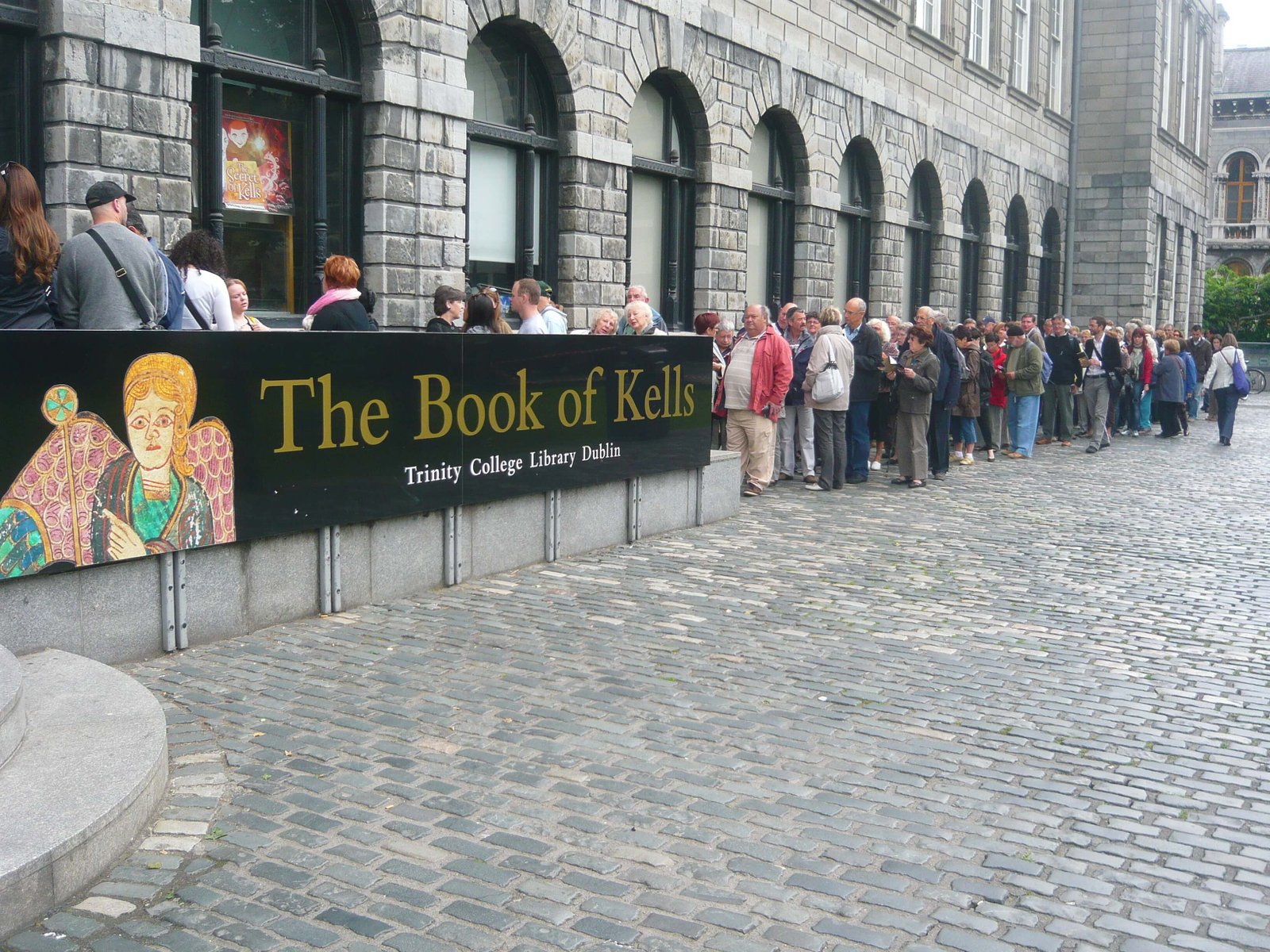
Next, I finally saw the Book of Kells itself! It did not disappoint. As I mentioned before, you only get to see two pages, since the book can only be open in one place at a time. They turn the page every month or so. This means that you won’t necessarily get to see pages with lots of decoration, and you almost certainly won’t get to see famous pages. (Manuscripts like this are very sensitive to light, so they can’t just leave it open to the highlights for long periods.)
For my visit, I got to see folios 200v-201r, part of the genealogy of Christ in the Gospel of St. Luke. I was really pleased with this selection. Since list pages have tons of opportunities for small, colorful, decorated initials beginning each entry, I got to see a lot of ornament. There were even a few creatures within the list of names. The book is larger than I expected, and it’s super thick. Upon seeing it in person, it’s really obvious that it wasn’t written with legibility in mind, as many other people have already observed. You can visit this link to find out what pages are currently on view, though it does not tell you when they will next change.
The book is housed in a small, dark room in a thick glass case with a guard who will yell at you if you even think about taking a photograph. It lays flat in the case, which doesn’t provide the best angle to view the details but does allow people to walk around and see it from all angles. Despite the steady stream of people, I could get up close, take my time to look without feeling rushed, and walk around the case more than once. You can’t re-enter after you leave, though, so make sure you’ve looked your fill before moving on.
The Long Room
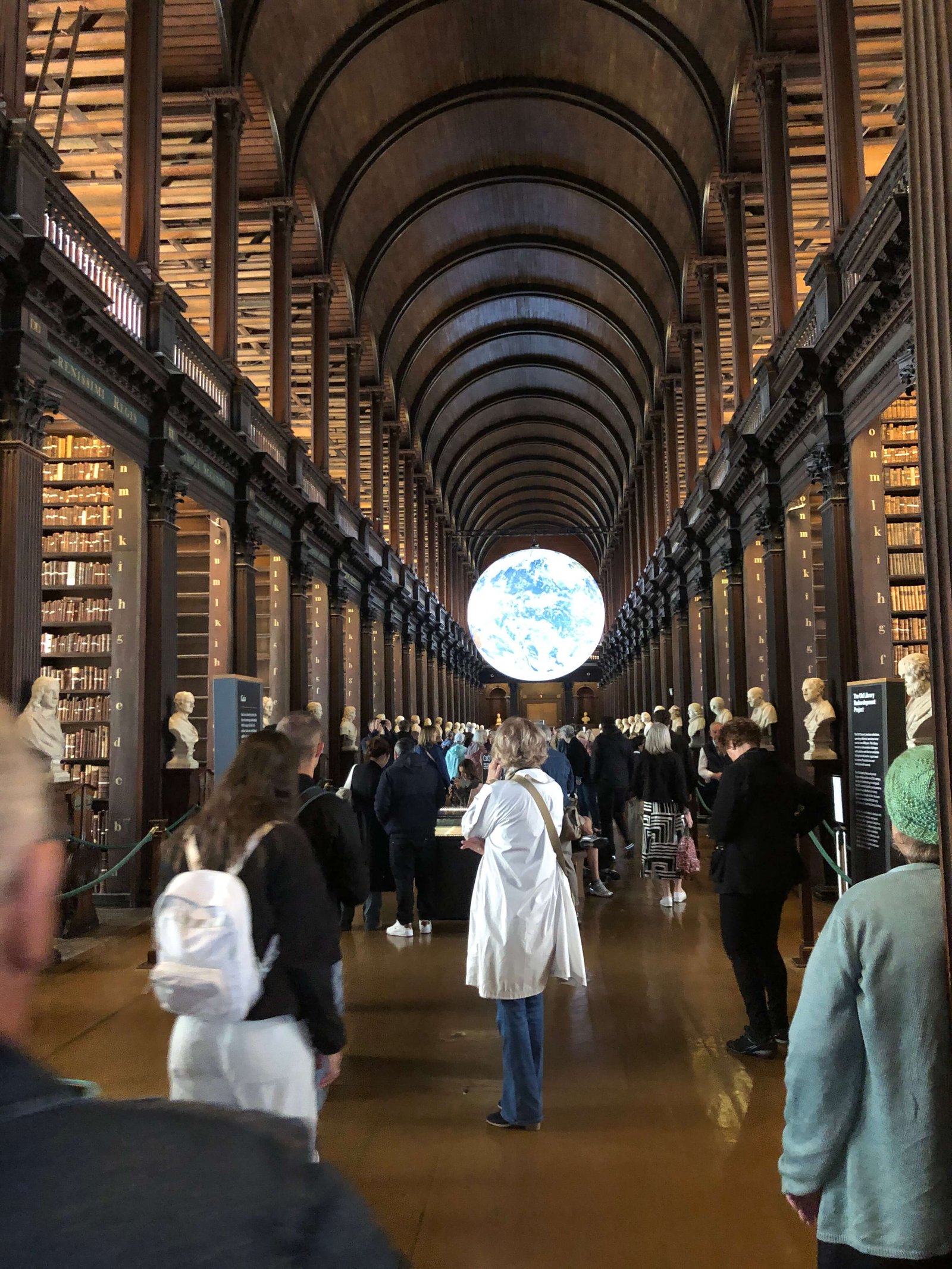
After seeing the Book of Kells, I walked up the stairs and entered the Long Room. Even if the name is unfamiliar to you, you’ve likely seen photographs of this grand library with its vaulted ceiling, dark wood paneling, and bookshelves on two levels. It’s even more majestic than I thought it would be – the stuff old library dreams are made of. There are very few books in the Long Room right now because they’re being restored, but that hardly spoils the ambiance at all. In their places are screens showing informative videos about the book restoration process.
Inside the Long Room, you can see dozens of busts of famous thinkers, including four notable women whose sculptures were added in 2022, a copy of the 1916 Proclamation of the Irish Republic, the medieval wooden harp that has become a symbol of Ireland (and the Guinness logo), a facsimile Book of Kells, and an art installation called Gaia featuring a model of the Earth hanging from the ceiling. Gaia looks super distracting in the photos but really wasn’t.
The Book of Kells Experience
The last thing on the agenda was the new Book of Kells Experience, which is housed in a temporary structure not far from the Old Library. I gather that this is where the book will be displayed while the Old Library is closed. This building contains a pair of three-dimensional, immersive videos, each about eight minutes in length. One is about the Book of Kells, focusing mainly on its history, and the other is about the Long Room and its restoration. Both videos are really memorable, imaginative, and just a bit dramatic. People who don’t like bright lights and surround sound may want to skip them, and the rest of us should sit down, since the 3d immersive aspect could be slightly disorienting. I really enjoyed the videos, but I don’t think they were as informative as the introductory exhibition in the Old Library.
Practicalities
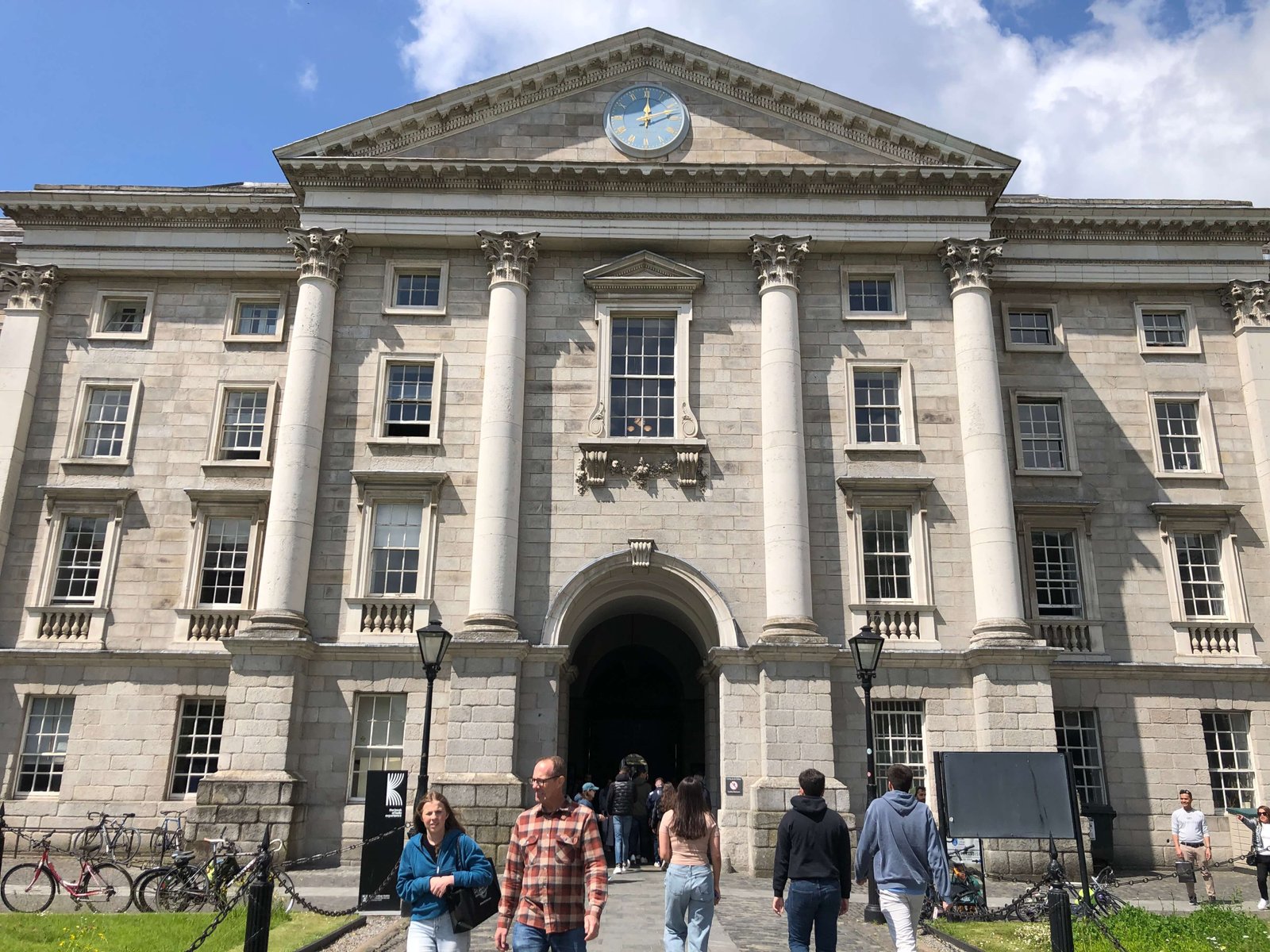
My entire adventure – the Trinity Trails tour, seeing the Book of Kells, visiting the Long Room, and the Book of Kells Experience – cost €33.50 per person and lasted two hours. Just seeing the Book of Kells and Old Library without the extras costs €19 per person. But there are several different ticket and package options depending on what you want to see and do, and the options will change once the Old Library is closed. The Book of Kells exhibit is open seven days a week, and you will definitely want to book your ticket in advance, since this is a popular attraction. Visit this page to see your options and book.
The Book of Kells exhibition has two gift shops – one in the Old Library and one in the Book of Kells Experience building. The latter is larger and has more offerings, so do your shopping there. There are several books about the Book of Kells, Trinity College Dublin sweatshirts, and all kinds of objects decorated with Book of Kells imagery – from socks and tee shirts to Christmas ornaments, notebooks, jewelry, and even hand-made Irish linen wall hangings. Some of it is cheap and touristy, but l0ts is actually really good and not terribly overpriced. (If you are from a non-EU country, ask for the tax-free receipt on purchases over €75 so you can claim the VAT tax amount back when you leave the EU.)
Trinity College has a very pretty campus that’s centrally located in Dublin and would be nice to walk around in good weather. It’s easy to access by foot or via the extensive Dublin bus system, and there are plenty of shops and pubs just outside the campus walls.
